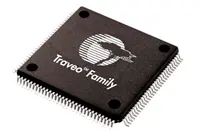Electronics News
Archive : 14 January 2016 год
 Samsung has announced that it has begun mass production of advanced logic chips utilising its 14nm LPP (Low-Power Plus) process, the second generation of the company’s 14nm FinFET process technology.
Samsung has announced that it has begun mass production of advanced logic chips utilising its 14nm LPP (Low-Power Plus) process, the second generation of the company’s 14nm FinFET process technology.
In Q1 of 2015 Samsung launched the Exynos 7 Octa processor built on the industry’s first 14nm LPE (Low-Power Early) process. With the 14nm LPP process, Samsung continues to demonstrate its unparalleled performance and power efficiency for its Exynos 8 Octa processor as well as its foundry customers including Qualcomm.
"We are pleased to start production of our industry-leading, second generation 14nm FinFET process technology that delivers the highest level of performance and power efficiency,” said Charlie Bae, executive vice president of sales and marketing, Samsung Electronics. "Samsung will continue to offer derivative processes of its advanced 14nm FinFET technology to maintain our technology leadership."
Incorporating three-dimensional FinFET structure on transistors is claimed to enable performance boost and low power consumption. Samsung’s 14nm LPP process is said to deliver up to 15% higher speed and 15% less power consumption over the previous 14nm LPE process through improvements in transistor structure and process optimisation.
14nm FinFET process is suitable for mobile and IoT applications and is expected to meet growing market demand for a range of high performance and power efficient applications from network to automotive.
Author
Tom Austin-Morgan
Source: www.newelectronics.co.uk
 Telit has acquired Bluetooth, Bluetooth Low Energy (BLE) and Near Field Communication (NFC) assets in hardware and software from Stollmann Entwicklungs und Vertriebs (Stollmann). Stollmann designs, develops and manufactures low-power Bluetooth modules and software solutions for short range wireless communications. Assets in acquisition include among others, Stollmann’s Bluetooth and NFC software stacks, ready-to-use modules and other intellectual property (IP) in wireless communications.
Telit has acquired Bluetooth, Bluetooth Low Energy (BLE) and Near Field Communication (NFC) assets in hardware and software from Stollmann Entwicklungs und Vertriebs (Stollmann). Stollmann designs, develops and manufactures low-power Bluetooth modules and software solutions for short range wireless communications. Assets in acquisition include among others, Stollmann’s Bluetooth and NFC software stacks, ready-to-use modules and other intellectual property (IP) in wireless communications.
“The IP we are acquiring will provide us with valuable expertise in additional short-range technologies including BLE, which is set to become the de-facto standard for local area and personal area IoT wireless connectivity,” said Oozi Cats, Telit’s chief executive officer. “As one of the IoT’s fastest growing wireless technology areas, this IP will enable us to expand our market reach with a more comprehensive end-to-end connectivity solution.”
Industry analyst firm MarketsandMarkets estimates the global Bluetooth Smart and ‘Smart-Ready’ market to be worth $5.6billion by 2020 with Bluetooth Smart shipments to surpass 1.2billion units in five years, up from 49million units in 2013.
The integration of Bluetooth, BLE and NFC technologies into Telit’s portfolio is claimed to enable businesses to accelerate innovation based on these technologies, leveraging Telit’s cellular and GNSS modules, mobile network connectivity and IoT platform services. These hardware and service combinations are expected to enable enterprises to move from idea to business with minimal effort or investment, bringing to market a wider range of consumer solutions than would otherwise be possible.
Pic: Oozi Cats, Telit’s chief executive officer
Author
Tom Austin-Morgan
Source: www.newelectronics.co.uk
 Following the launch in October 2015 of its Synergy platform, Renesas Electronics has announced the release of the Synergy Software Package (SSP) version 1.0.0, mass production availability of its S7G2 Synergy MCUs and availability of Verified Software Add-on (VSA) software from its partners.
Following the launch in October 2015 of its Synergy platform, Renesas Electronics has announced the release of the Synergy Software Package (SSP) version 1.0.0, mass production availability of its S7G2 Synergy MCUs and availability of Verified Software Add-on (VSA) software from its partners.
The Synergy Platform, intended to speed the development of embedded and IoT applications, has been designed to provide engineers with a range of configured and tested system elements. This, the company believes, will reduce time to market by months and allow system manufacturers to differentiate their products.
The SSP integrates a real time operating system with a set of utilities, drivers, libraries, software stacks and an application framework optimised for the Renesas Synergy MCU architecture. Version 1.0.0 is said to be fully qualified and suitable for use in mass production.
The S7G2 MCUs are intended for use in high performance human machine interface applications. Built around a Cortex-M4 core running at 240MHz, the MCUs have up to 4Mbyte of flash, 640kbyte of SRAM, a graphics LCD controller and a capacitive touch sensing unit. A range of packages is also available.
Meanwhile, Renesas says Cypherbridge Systems, Icon Labs and Skkynet are the first members of the VSA programme to offer production ready software for the platform via the Synergy Gallery.
Author
Graham Pitcher
Source: www.newelectronics.co.uk
 Cypress has expanded its automotive portfolio with the introduction of Traveo MCUs manufactured on a 40nm process. The move is said by the company to enable higher performance and more cost-efficient implementations of instrument clusters. The use of 40nm technology will also enable more on chip flash for advanced applications, as well as making it easier to implement firmware over the air (FOTA) updates.
Cypress has expanded its automotive portfolio with the introduction of Traveo MCUs manufactured on a 40nm process. The move is said by the company to enable higher performance and more cost-efficient implementations of instrument clusters. The use of 40nm technology will also enable more on chip flash for advanced applications, as well as making it easier to implement firmware over the air (FOTA) updates.
The S6J33XX series is said to provide automotive manufacturers with a cost-effective platform for use in classic instrument clusters featuring small TFT displays. Based on the ARM Cortex-R5 processor running at 240MHz, the MCUs support CAN-FD communications for increased data bandwidth. Up to 4Mbyte of flash is available for application storage, while other features includethe enhanced secure hardware extension (eSHE) and the HyperBus interface.
Mathias Brauer, director of product marketing for automotive MCUs, noted: “The MCUs can connect to a range of networks, including MOST and Ethernet. There are also six CAN-FD channels. Security is important, so all devices have eSHE on chip, as well as ISO26262 safety features.”
Cypress has also introduced a transceiver for the low-speed Clock Extension Peripheral Interface (CXPI), which is expected to succeed the Local Interconnect Network (LIN) protocol.
Author
Graham Pitcher
Source: www.newelectronics.co.uk

